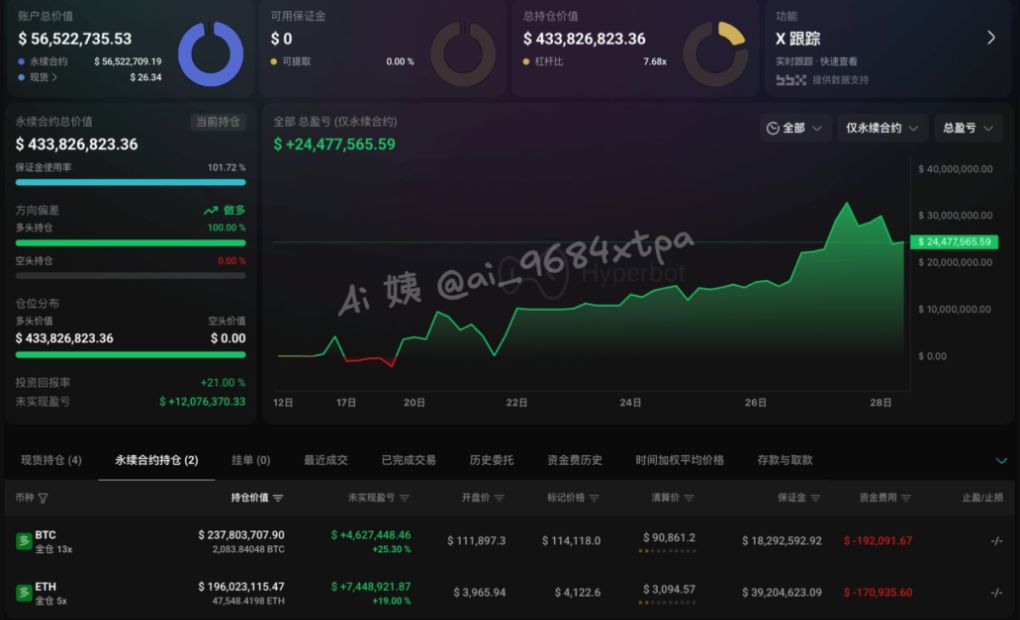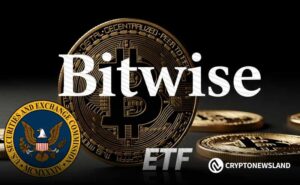A trader known as the “100% win-rate whale” increased his position by another 41.68 BTC (approximately $4.77 million) on October 28, and canceled all pending orders, indicating that he may have temporarily completed a phase of accumulation.
Currently, he holds a long position of 2,083.84 BTC (worth $237 million) and 47,548.42 ETH (worth $196 million), with total long positions approaching $433 million. This whale’s series of precise operations since mid-October has created an almost legendary reputation in the market.

I. Lightning Rise: Dissecting the Whale’s October Performance
In the cryptocurrency market, every move by a “whale” attracts attention, but this trader’s series of operations in October remains astonishing. Through precise switching between long and short positions and excellent timing, he successfully captured every beat of market volatility.
Based on his publicly available on-chain transaction records, we have outlined his key operations in October:
Date | Operation & Impact |
October 15 | Began large-scale shorting of BTC, establishing a bearish stance |
October 16 | Quickly reversed direction, started building BTC long positions |
October 17-21 | Continued to increase BTC and ETH long positions |
October 22 | Closed all long positions, realizing a one-time profit of $6.04 million |
October 22-23 | Switched to shorting BTC, adjusting direction again |
October 24 | Closed all long positions, profiting $1.774 million; opened new ETH long position (5x leverage) |
October 26 | Continued to add to positions, total long positions approaching $300 million |
October 28 | Added 41.68 BTC, canceled all pending orders, positions unchanged |
● This whale is known for his flexible switching and profiting from both long and short positions. He does not stubbornly stick to one direction but quickly adjusts his strategy according to market changes. For example, on October 22, after closing all long positions and profiting $6.04 million, he immediately switched to shorting, demonstrating his keen market sense.
● In terms of position management, he skillfully uses limit orders to preset entry points, effectively controlling the cost of building positions. At the same time, he dares to hold positions after key data releases, showing extreme confidence in his own judgment and strong risk tolerance.
II. Behind the Myth: Multi-dimensional Interpretation of the Whale’s Strategy
The operations of this “100% win-rate whale” are not mere gambling, but follow a clear strategic logic.
● The core is high leverage combined with massive positions, creating short-term trends favorable to himself by guiding market sentiment and self-fulfilling prophecies.
In one operation in March, he used 50x high leverage to establish a massive long position in a short period, steering the market in his favor.
● When positions show large unrealized profits, he decisively converts them into realized profits—by withdrawing the profit portion or even the principal from the margin, removing these funds from exchange risk. Essentially, this operation “locks in” profits without closing the position.
Since Hyperliquid’s HLP insurance fund takes over positions at the liquidation price, the whale effectively sells the remaining positions at the liquidation price, without worrying about slippage losses caused by market sell pressure, as these losses are ultimately borne by the HLP fund.
● In sharp contrast to another famous whale “Maji,” who was liquidated for $12.56 million during the October 11 crash, this 100% win-rate whale’s risk control is much more sophisticated. After being liquidated, “Maji” had to switch to opening smaller positions, transferring only $1.85 million to Hyperliquid, with the current address holding just $1.13 million.
III. Market Impact: On-chain Game Triggered by the Whale
This 100% win-rate whale’s large-scale operations not only influence market sentiment but also trigger real long-short battles on-chain. His massive long positions have created a clear market bias on the Hyperliquid platform, attracting a large number of followers.
● In the current bull run, starting from October 25, a clear counterparty emerged, continuously increasing BTC short positions to confront the whale. As of October 26, the counterparty’s short position had an unrealized loss of up to $1.85 million. This clearly shows that there is significant disagreement in the market about future trends.
● The Hyperliquid platform itself has also become both a beneficiary and a risk bearer in this whale game. During the October 11 crash, according to on-chain analyst @mlmabc, a shorting whale made a single-day profit of about $190 million to $200 million on Hyperliquid. At the same time, Hyperliquid’s HLP single-day profit reached $40 million, with an annualized rate soaring to 190% and an overall capital return of 10-12%.
But such high returns also come with high risks. When whales take extreme actions, the HLP insurance fund may bear huge losses. In one incident in March, a whale withdrew most of his principal and profits, actively raising the liquidation price, making the remaining positions highly susceptible to liquidation.
Position Type | Position Size | Average Entry Price | Current Status |
BTC Long | 2,083.84 BTC ($237 million) | $111,897.3 | Unrealized profit |
ETH Long | 47,548.42 ETH ($196 million) | $3,965.94 | Unrealized profit |
Counterparty Short | Undisclosed size | Undisclosed | Unrealized loss once reached $1.85 million |
IV. Hidden Risks: Potential Crisis Behind the Perfect Record
Although this whale has maintained a 100% win rate so far, there are multiple risks hidden in his operations, and the market is speculating when “that one” failure will arrive.
The Double-Edged Sword of High Leverage
● The whale frequently uses 5x to 12x high leverage to amplify returns, but this is a double-edged sword in the highly volatile cryptocurrency market. If the market experiences an unexpected sharp reversal, high-leverage positions are extremely vulnerable to liquidation risk.
● Stories of huge profits and catastrophic losses are nothing new in the crypto trading world. Even well-known traders like “Maji” lost a staggering $12.56 million in principal during the market crash on October 11.
Exchange Mechanism Risks
● Centralized exchanges know exactly where traders’ liquidation points are, and market makers may use this data. In low liquidity situations, it doesn’t take much to force price movements. This action liquidates large positions, forcing assets to be sold at bottom prices. The same entity then buys these assets at low prices—and profits from the rebound. This tactic is known as liquidation hunting—very common in the crypto world.
● The $100 million liquidation event of James Wen exposed this risk—a sudden price candle appeared on one exchange, just enough to liquidate his position, while no similar move was seen on other exchanges.
The Real Dilemma for Followers
● For ordinary investors, copying whale operations faces many challenges. Due to information asymmetry and time lag, by the time retail investors see the whale’s move, the best entry point is often already missed.
● More importantly, because the whale’s entry points are relatively high, addresses copying his trades are already showing an unrealized loss of $846,000. This clearly shows that even the “100% win-rate” label cannot guarantee that every subsequent operation will be profitable.
V. Outlook: Where Will the Whale Era Go?
The future operations and market impact of this “100% win-rate whale” have several key points worth continuous attention:
Position Changes and Platform Response
● It is necessary to closely monitor whether the whale will continue to increase his position or start reducing it. His recent move to cancel all pending orders may signal the beginning of a new strategic phase.
● At the same time, trading platforms like Hyperliquid may also adjust their rules in response to whale strategies. After the March incident, Hyperliquid did adjust its rules, but the industry views this as a stopgap measure that fails to address the root problem.
Overall Market Liquidity
● It’s not just this whale—the entire crypto market faces risks from the broader financial market. According to JPMorgan research, AI-related corporate debt has surpassed traditional banking, becoming the largest sector in the investment-grade bond index, accounting for 14% and with total debt exceeding $1.2 trillion.
● This trend has raised market concerns about a credit bubble. Analysts warn that if a paradigm shift occurs in the AI sector, the resulting credit collapse could be even more severe than a stock market crash. Such macro risks may indirectly affect the liquidity and stability of the cryptocurrency market through institutional investors’ asset allocation adjustments.




